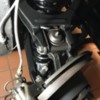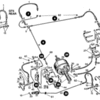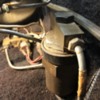A previous Pantera brakes thread got overly informative and so long that I can't remember what the most important points were.
I have a 1972 Pantera and a 1972 Corvette. I've owned the Pantera forever and the Vette for three years. The Pantera is like a new car, on the other hand the Corvette has been 'rode hard and put away wet' many times, but the Corvette brakes are still great and far, far better than the Pantera brakes.
There was much discussion concerning the proportioning valve being better out then in, and how newer larger tires will affect brake requirements. I have 17/10 front wheels and 18/12 rear wheels, but the stock 11" rotors and calipers and stock proportioning valve. The pads are virtually new and the discs not worn or grooved. The brake petal feels solid. Because I have Webers on the car, all my vacuum is supplied by an electric CVR vacuum pump that provides 20in of vacuum, I checked.
Rather than installing a totally new, costly braking system, larger rotors and all, I'd like to start with new hydraulics, mainly the master cylinder and booster, and dispense with the proportioning valve.
Does this make sense? Any other cheaper ideas?
Thank you






